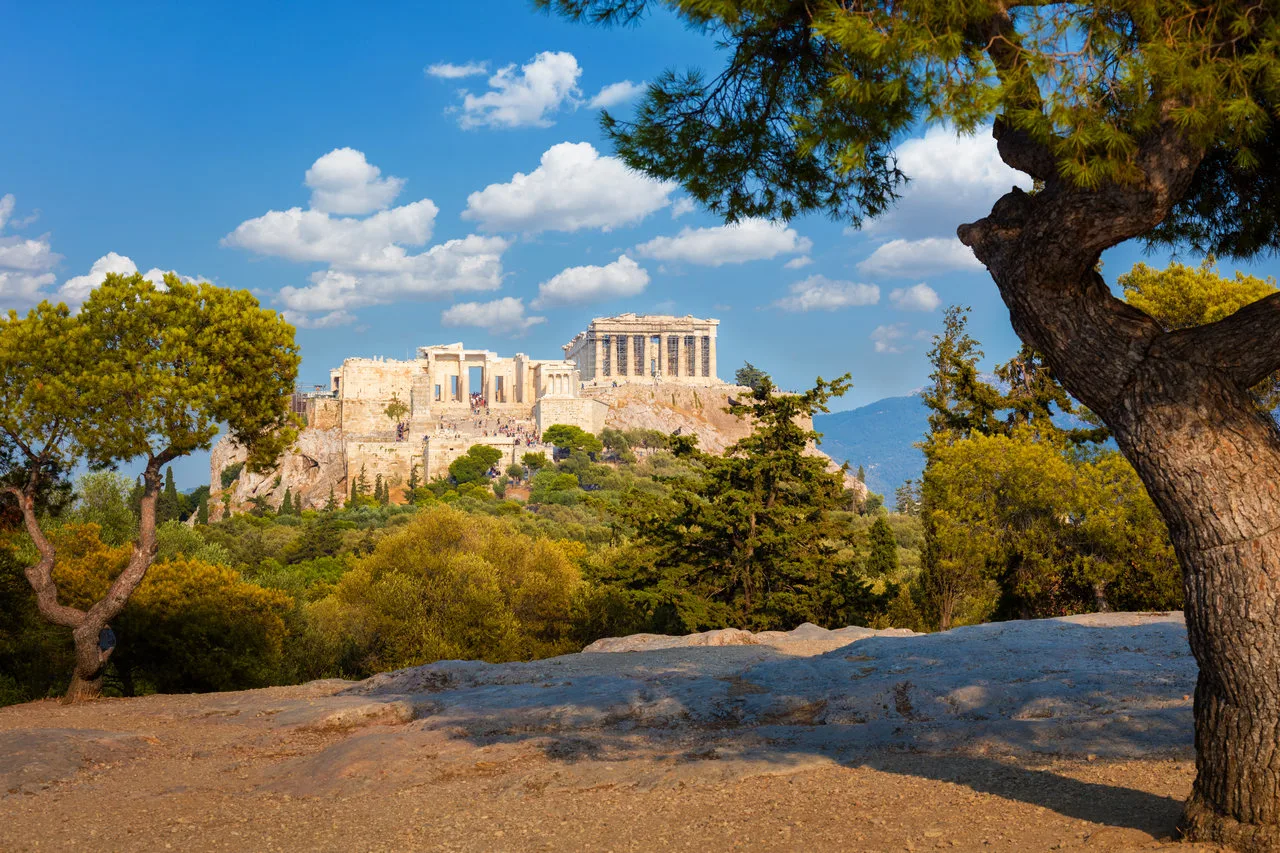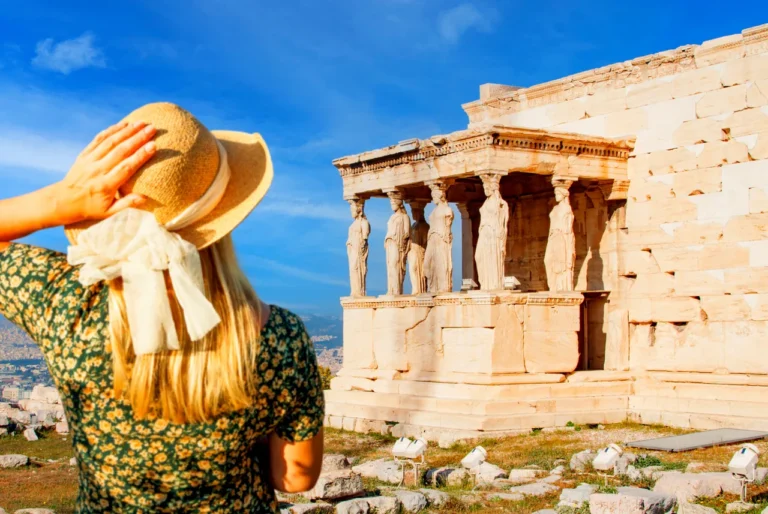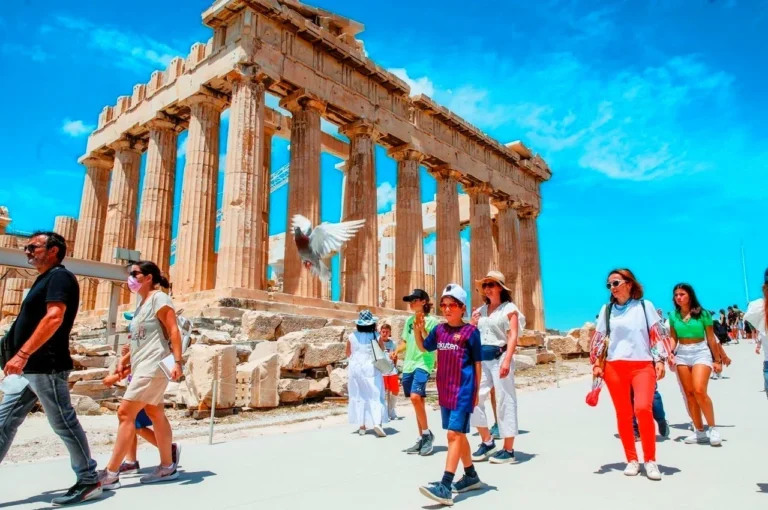Acropolis of Athens: The Complete Visitor’s Guide
The Acropolis of Athens is an ancient citadel located on a rocky outcrop above the city of Athens, Greece. It contains the remains of several significant ancient Greek buildings, most notably the Parthenon, and is considered one of the world’s greatest cultural monuments.
What does the word Acropolis mean?
The term “acropolis” is derived from the Greek words “akros” (highest) and “polis” (city), which together mean “high city”. It refers to a fortified part of an ancient Greek city, usually located on a hill or a high part of the city, serving as a protective citadel and a center for religion and worship. The Acropolis of Athens is the most famous example of an acropolis.
Location and Significant Facts
Situated on a hill rising 490 feet (150 meters) above sea level in the city of Athens, the Acropolis covers an area of about 7 acres (3 hectares). Its commanding position made it an ideal location for a citadel in ancient times. The Acropolis is home to numerous important ancient Greek architectural masterpieces, including the Parthenon, the Propylaea, the Erechtheion, and the Temple of Athena Nike.
Significance in Ancient Greek Civilization
In ancient Greek civilization, the Acropolis held immense religious and cultural significance. It was dedicated to the goddess Athena, the patron deity of Athens. The buildings on the Acropolis, particularly the Parthenon, were the greatest achievements of the classical Greek architecture of the 5th century BCE, a time when Athens was at the peak of its power. The Acropolis served as a symbol of Athenian democracy, wealth, and cultural superiority.
Historical and Cultural Importance Today
Today, the Acropolis is a UNESCO World Heritage site and one of the most recognizable landmarks in the world. It attracts millions of visitors each year who come to marvel at the architectural and artistic achievements of ancient Greece. The Acropolis continues to be a powerful symbol of the cultural legacy of ancient Greece and its enduring influence on Western civilization. Ongoing restoration and preservation efforts aim to ensure that this iconic site will continue to inspire and educate future generations about the rich history and cultural heritage of ancient Greece.
Visiting the Acropolis of Athens
A visit to the Acropolis is an unforgettable experience that allows you to walk in the footsteps of ancient Greeks and witness the grandeur of one of the world’s most iconic archaeological sites.
Planning Your Visit: Tips and Best Times to Explore
When planning your visit to the Acropolis, consider the following tips:
- Best times to visit: To avoid crowds and heat, visit early in the morning (8:00-9:00 AM) or later in the afternoon (after 5:00 PM). The best months to visit are May, June, September, and October, when the weather is mild and comfortable.
- Ticket information: Purchase your tickets online (link) in advance to avoid long queues at the entrance. Combo tickets are available, granting access to multiple archaeological sites in Athens.
- A strict timed entry system is in place. Visitors can only enter during their booked time slot.
- Dress appropriately: Wear comfortable shoes with good traction, as the paths on the Acropolis can be slippery. Bring a hat, sunglasses, and sunscreen to protect yourself from the sun.
Admission Fees
Visiting the Acropolis is not free. As of 2023, the standard ticket price is €20 during the high season (April 1 to October 31) and €10 during the low season (November 1 to March 31). The price of the ticket will increase to €30 in 2025. However, there are reduced fees and free admission days for certain groups, such as children under 18, students, and seniors over 65 from the EU.
Special combo ticket: €34, valid for 5 days, includes entrance to Acropolis and 6 more archaeological sites (Ancient Agora, Roman Agora, Hadrian’s Library, Temple of Zeus, Kerameikos, Aristotle’s School)
Official e-tickets are available to purchase online in advance at https://hhticket.gr or various third-party websites with slightly higher prices.
Opening Hours and Seasons
The Acropolis is open year-round, but with varying hours depending on the season:
- Summer Season (April 1 to October 31): 8:00 AM to 7:30 PM, last admission at 7:00 PM
- Winter Season (November 1 to March 31): 9:00 AM to 5:00 PM, last admission at 4:30 PM
The site is closed on certain public holidays, such as January 1, March 25, May 1, Easter Sunday, and December 25-26. More info.
Accessibility for Persons with Mobility Issues
The Acropolis has taken steps to improve accessibility for visitors with mobility issues, but challenges remain due to the site’s steep and uneven terrain. Here are some key points:
- A wheelchair accessible elevator is available at the main entrance to help visitors reach the top of the Acropolis.
- Once on top, visitors can access the main monuments via paved pathways, although some areas may still be difficult to navigate due to uneven surfaces and steps.
- Wheelchair rental is not available on-site, so visitors requiring one should make arrangements beforehand.
It is advisable for visitors with mobility issues to assess their individual needs and limitations before visiting the Acropolis and to plan accordingly. Guided tours designed for individuals with mobility challenges may also be an option to consider.
Walking Through History: A Tourist’s Guide to the Acropolis
Upon entering the Acropolis, you’ll follow the path of the ancient Panathenaic Way, the processional route used during the Panathenaic Festival. As you ascend the hill, you’ll pass through the Propylaea, the monumental gateway to the Acropolis.Once inside, you’ll be greeted by the sight of the Parthenon, the largest and most iconic temple on the Acropolis. Take time to admire its impressive columns and intricate sculptural details, which showcase the skill and artistry of ancient Greek architects and sculptors.
Next, visit the Erechtheion, famous for its Porch of the Caryatids. The six sculpted female figures that support the porch’s roof are replicas; the originals are housed in the Acropolis Museum to protect them from environmental damage.
Don’t miss the Temple of Athena Nike, a small but elegant temple dedicated to Athena in her role as the goddess of victory. The temple’s frieze depicts scenes from battles between the Greeks and the Persians, highlighting the Athenians’ military prowess.
As you explore the Acropolis, take in the breathtaking views of Athens and the surrounding landscape. The Acropolis offers a unique vantage point from which to appreciate the city’s rich history and modern-day vibrancy.
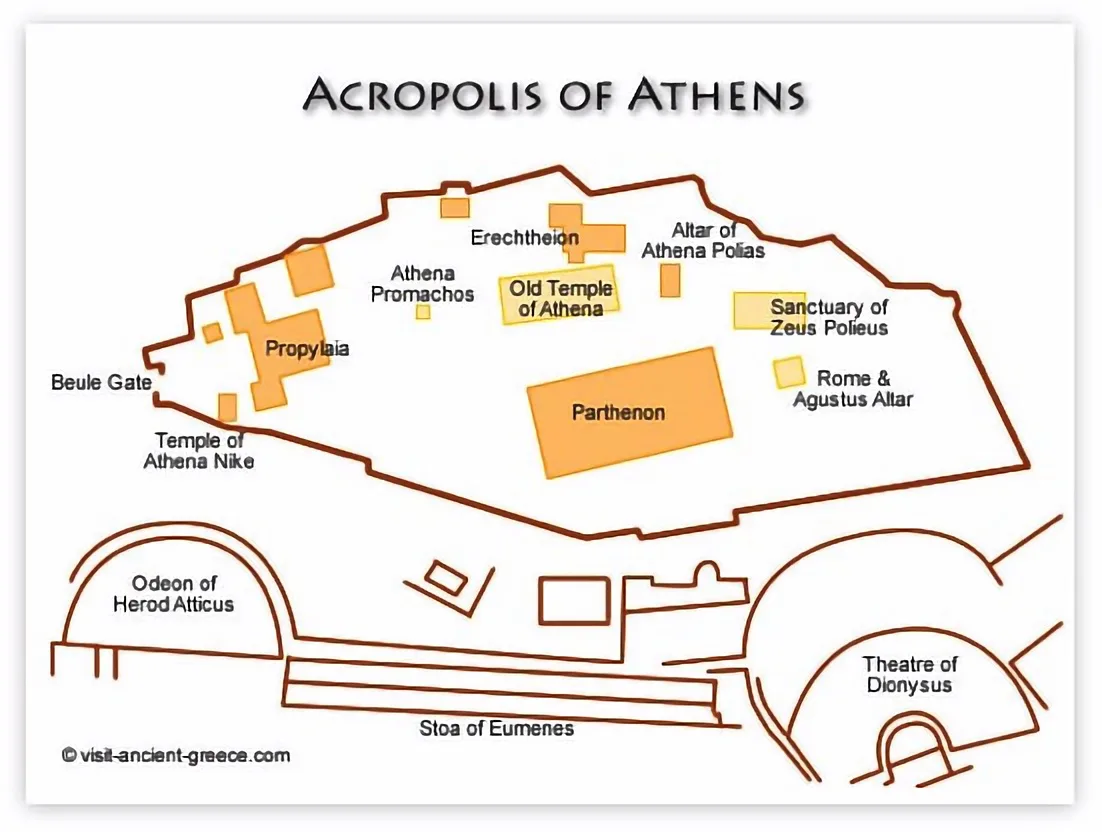
The History of the Acropolis
The Acropolis has a rich and fascinating history spanning thousands of years, from its early beginnings as a Mycenaean stronghold to its current status as an iconic symbol of ancient Greek civilization.
Early Beginnings: From Mycenaean Stronghold to Religious Center
The Acropolis has been inhabited since the Neolithic period (4000-3200 BCE), but it was during the Mycenaean era (1600-1100 BCE) that the site began to take on its distinctive form. The Mycenaeans built a massive fortification wall around the hill, turning it into a powerful stronghold. By the 8th century BCE, the Acropolis had become a religious center dedicated to the goddess Athena.
The Golden Age of Athens: Pericles and the Construction Boom
The Acropolis reached its zenith during the Golden Age of Athens in the 5th century BCE under the leadership of the statesman Pericles. Pericles initiated an ambitious building program that included the construction of the Parthenon, the Propylaea, the Erechtheion, and the Temple of Athena Nike. These magnificent structures, built from gleaming white marble, embodied the wealth, power, and cultural sophistication of Athens at its peak.
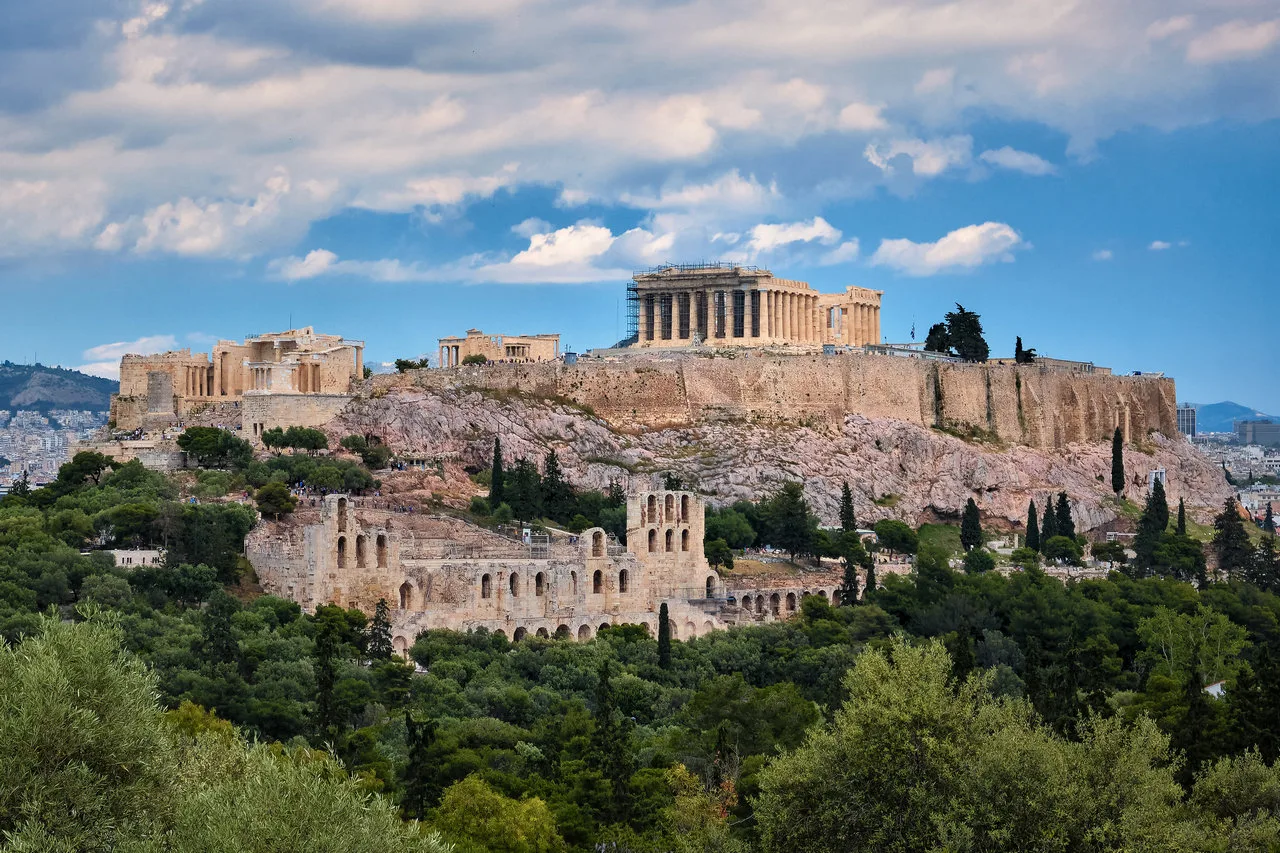
Invasion, Destruction, and Restoration: A Timeline of Resilience
Throughout its long history, the Acropolis has faced numerous challenges and setbacks:
- In 480 BCE, the Persians invaded Athens and burned the buildings on the Acropolis.
- In the 4th century BCE, the Acropolis was again damaged during the Peloponnesian War.
- During the Ottoman occupation of Greece (1458-1833), the Parthenon was converted into a mosque, and later, a gunpowder explosion severely damaged the building.
- In the early 19th century, Lord Elgin removed many of the Parthenon’s sculptural decorations, now known as the “Elgin Marbles,” which remain a source of controversy.
Despite these challenges, the Acropolis has demonstrated remarkable resilience. Restoration efforts began in the 19th century and continue to this day, ensuring that this iconic site will endure for generations to come as a testament to the enduring legacy of ancient Greek civilization.
Architectural Marvels of the Acropolis
The Acropolis is home to some of the most iconic and influential buildings in the history of Western architecture. These structures, built during the Golden Age of Athens in the 5th century BCE, continue to inspire and captivate visitors from around the world.
The Parthenon: A Masterpiece of Doric Architecture
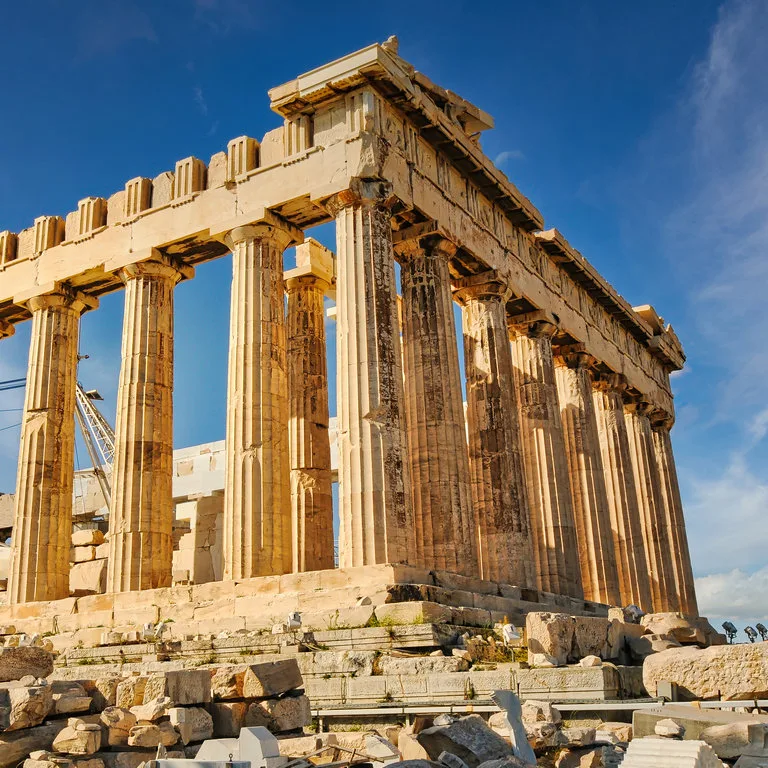
The Parthenon, dedicated to the goddess Athena, is the most famous building on the Acropolis and a quintessential example of Doric architecture.
Built entirely of white marble, the Parthenon features a rectangular floor plan surrounded by a peristyle of columns. The building’s harmonious proportions, subtle curves, and exquisite sculptural decorations make it a true masterpiece of ancient Greek architecture.
The Erechtheion: Where History and Mythology Meet
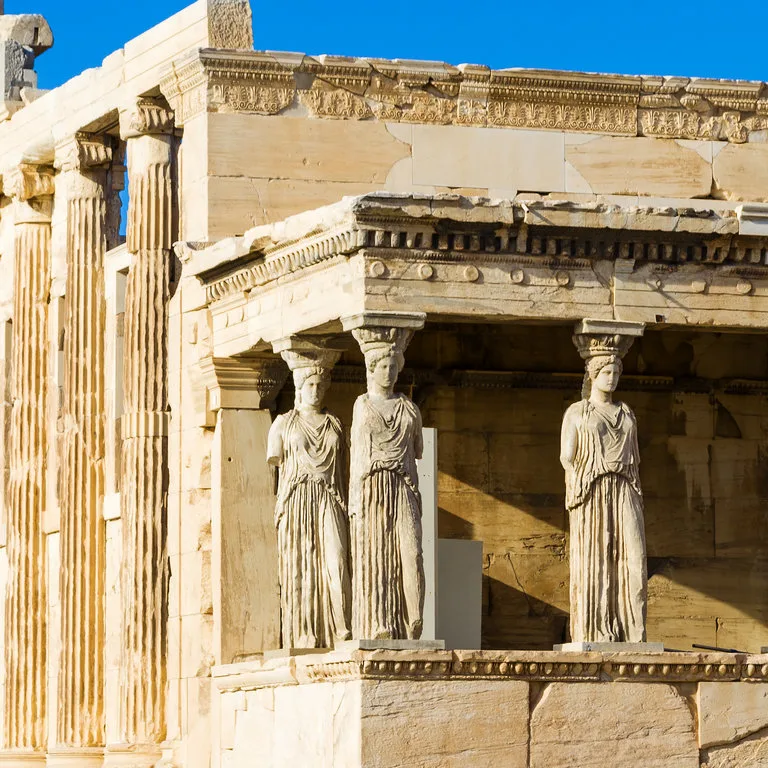
The Erechtheion, located on the north side of the Acropolis, is an ancient Greek temple dedicated to both Athena and Poseidon. Its unique design incorporates two distinctive porches. The Porch of the Caryatids, also known as the Porch of the Maidens, features six sculpted female figures (caryatids) supporting the roof. This porch overlooks the Parthenon.
The other porch, situated on the north side of the building, is known as the North Porch and features Ionic columns. The Erechtheion is steeped in mythology and is said to mark the spot where Athena and Poseidon competed for the patronage of Athens.
The Propylaea: Gateway to the Ancient World
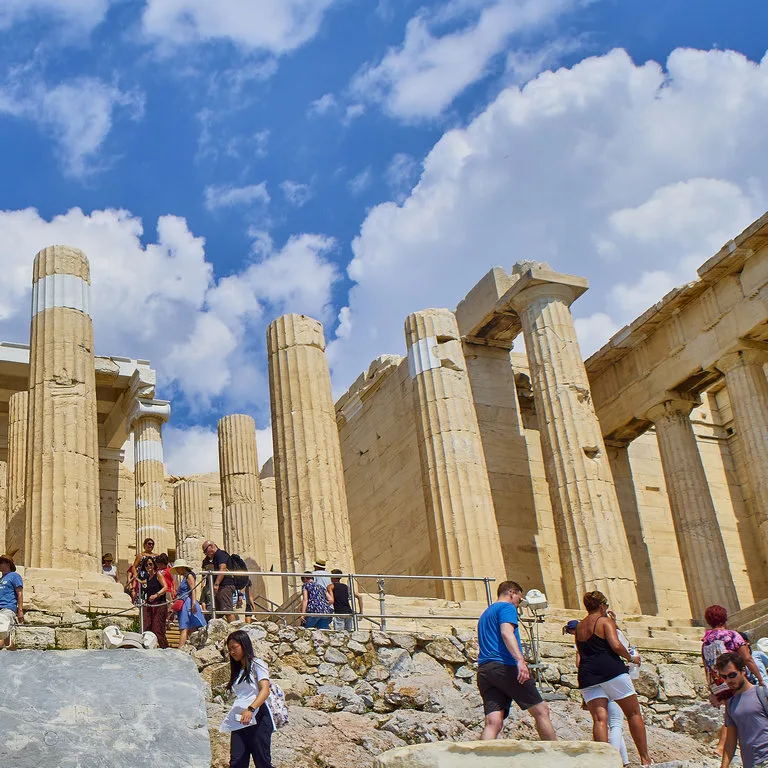
The Propylaea serves as the monumental entrance to the Acropolis. This impressive gateway, built from white marble, features a central building flanked by two wings.
The Propylaea’s design incorporates both Doric and Ionic architectural elements, showcasing the skill and creativity of ancient Greek architects.
The Temple of Athena Nike: A Tribute to Victory
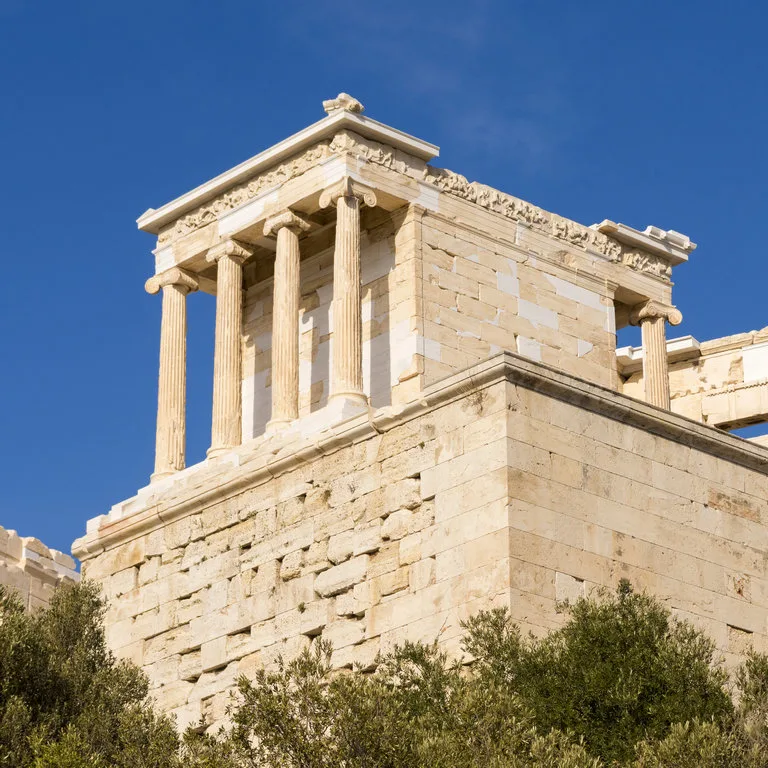
The Temple of Athena Nike, situated on a bastion near the Propylaea, is a small but elegant Ionic temple dedicated to Athena in her role as the goddess of victory.
The temple’s frieze depicts scenes from the Greek victory over the Persians, highlighting the Athenians’ pride in their military successes.
Despite its small size, the Temple of Athena Nike is a powerful symbol of Athenian strength and resilience.
These architectural marvels of the Acropolis not only showcase the extraordinary skill and artistry of ancient Greek architects and sculptors but also embody the values, beliefs, and aspirations of the Athenian people during the city’s Golden Age.
Lesser-Known Treasures
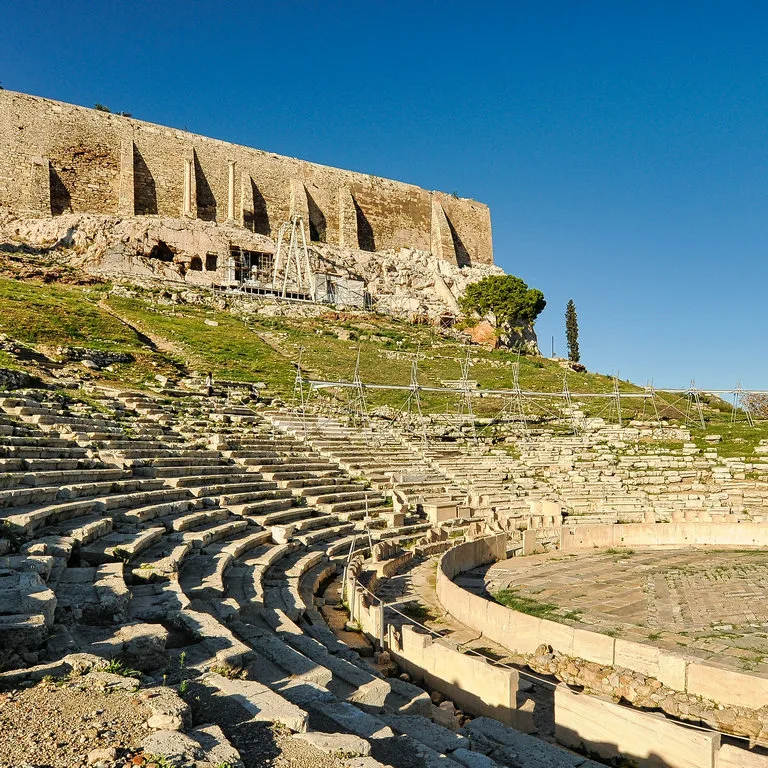
The Acropolis is home to several other significant structures that contribute to the sacred and cultural importance of the site. The Odeon of Herodes Atticus, a large stone theater built in 161 CE, is located on the southwest slope of the Acropolis. The theater, which could seat up to 5,000 spectators, was used for musical performances and rhetorical competitions.
The Theater of Dionysus, situated at the foot of the Acropolis, is the birthplace of Greek tragedy. The theater, dedicated to Dionysus, the god of wine and theater, could accommodate up to 17,000 spectators and was the site of the famous Athenian dramatic festivals.
The Sanctuary of Asclepius, located on the south slope of the Acropolis, was a healing center dedicated to Asclepius, the god of medicine. The sanctuary included temples, altars, and a dormitory where patients could stay while seeking healing from the god.
The Stoa of Eumenes, a long, two-story colonnade built in the 2nd century BCE, stretches along the south slope of the Acropolis. The stoa provided shelter for visitors and served as a gathering place for philosophical discussions and lectures.Together, these structures form a remarkable ensemble that showcases the religious, cultural, and intellectual life of ancient Athens.
The Parthenon, as the centerpiece of this complex, serves as a symbol of the city’s wealth, power, and devotion to Athena, while the surrounding buildings and monuments contribute to the Acropolis’ status as one of the most significant archaeological sites in the world.
Architects and Sculptors
Iktinos and Kallikrates
Iktinos and Kallikrates are credited with the design of the Parthenon, the most iconic structure on the Acropolis. The Parthenon was constructed between 447 and 438 BC and is dedicated to the goddess Athena Parthenos.
Mnesikles
Mnesikles was the architect of the Propylaia, the monumental gateway to the Acropolis, which was built between 437 and 432 BC. Mnesikles ingeniously combined the Doric and Ionic orders in the design of the Propylaia, using Ionic for the internal columns and Doric for the external ones.
Kallikrates
Kallikrates is also credited with the design of the Temple of Athena Nike, an Ionic temple completed in 420 BC. This temple is known for its elegance and the use of beautiful white Pentelic marble.
Sculptors and Artists
The Acropolis temples were adorned with the work of the most renowned sculptors and artists of ancient Greece.
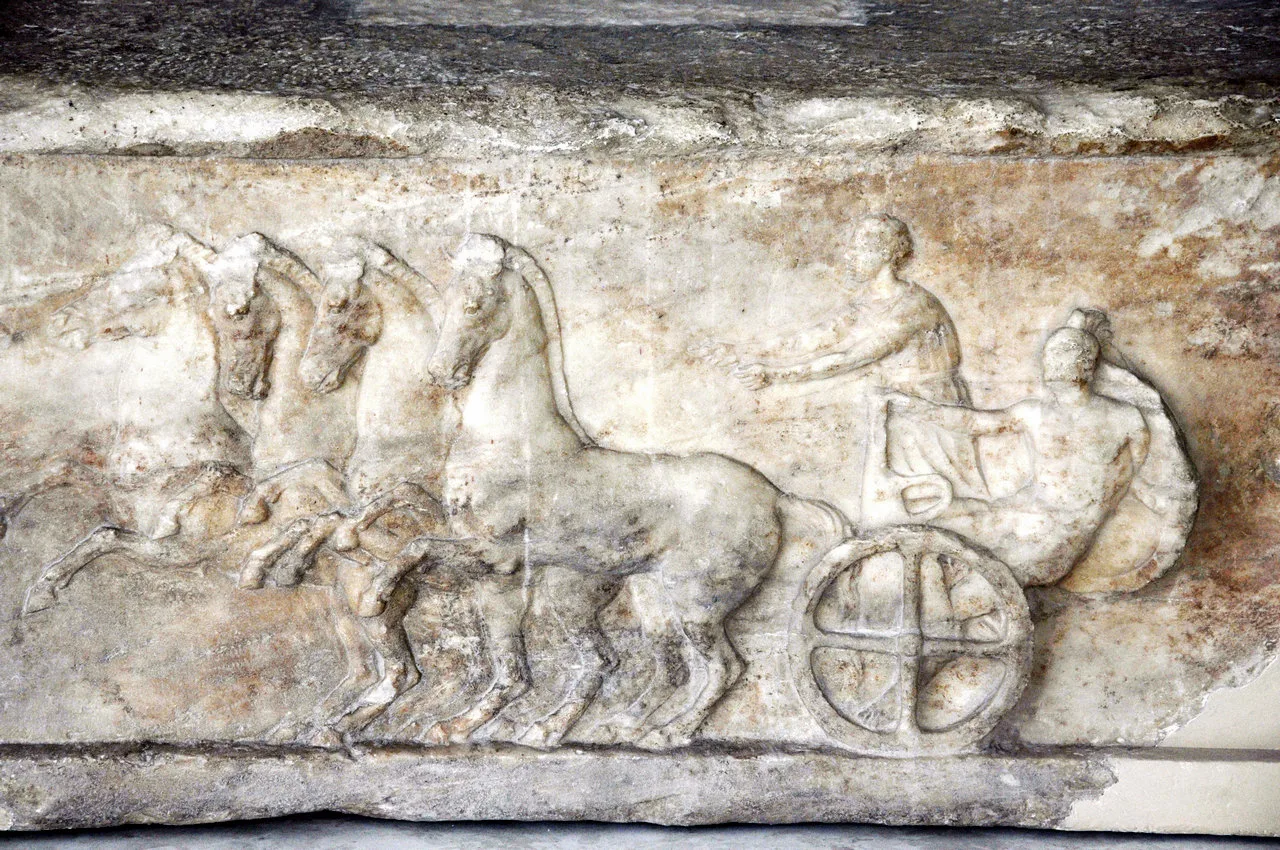
Pheidias
Pheidias, the most famous sculptor of ancient Greece, oversaw the sculptural decoration of the Parthenon and created the colossal statue of Athena Parthenos that stood inside the temple. He is also known for the statue of Athena Promachos that once stood on the Acropolis.
Alkamenes and Agorakritos
Alkamenes and Agorakritos were sculptors who worked under the guidance of Pheidias and contributed to the sculptural decoration of the Acropolis.
Decorative Elements and Artistic Contributions
The Acropolis temples were richly decorated with sculptures, friezes, and other artistic elements that showcased the skill and creativity of ancient Greek artists.
Sculptures
The Parthenon was richly decorated with sculptures designed by Pheidias, which included the pediments, metopes, and the frieze. These sculptures depicted various episodes from Greek mythology and a religious procession of the people of Athens.
Frieze and Metopes
The frieze of the Parthenon represents the Panathenaic procession, while the metopes depict scenes such as the battle between the Centaurs and Lapiths.
Caryatids
The Erechtheion is famous for its porch of the Caryatids, where the female figures serve as architectural supports in place of columns. It is believed that the Caryatids were created by sculptors from the workshop of Alkamenes, one of the most prominent sculptors of the late 5th century BC.
Colorful Temples and Decorative Elements
Contrary to the common perception of ancient Greek temples as plain white, they were originally colorful. The temples on the Acropolis, including the Parthenon, would have been decorated with vibrant colors, which have since faded over time.
The Acropolis Museum
The Acropolis Museum, situated at the foot of the Acropolis, is a modern museum that houses an extensive collection of artifacts from the archaeological site, providing visitors with a comprehensive understanding of the Acropolis’ rich history and cultural significance.
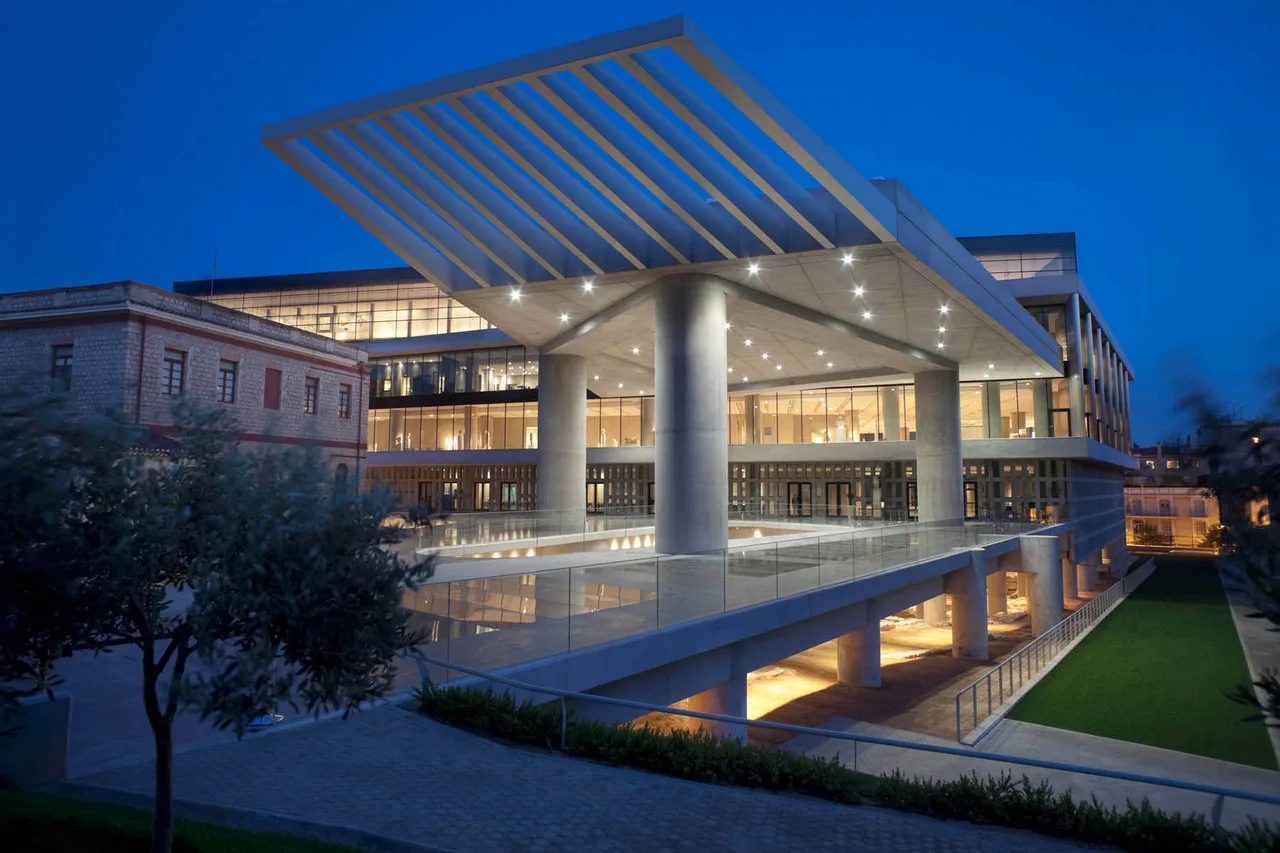
Opened in 2009, the new Acropolis Museum is a state-of-the-art facility designed by Swiss-American architect Bernard Tschumi. The museum’s design is a striking blend of modern architecture and ancient history, with glass floors allowing visitors to see the archaeological excavations beneath the building. The museum’s layout and exhibits are carefully curated to provide a chronological journey through the Acropolis’ history, from its earliest settlements to the present day.
Highlights of the Collection
The Acropolis Museum’s collection offers fascinating insights into the lives, religious practices, and artistic achievements of the ancient Athenians. Notable exhibits include the original Caryatids from the Erechtheion, a significant portion of the Parthenon Frieze, and the Peplos Kore, an archaic statue believed to represent Athena.
Cultural Significance
The Acropolis has held immense cultural significance throughout its long history, serving as a center of religion, politics, and art in ancient times and remaining a powerful symbol of Greek heritage and pride today.
The Acropolis in Ancient Times: Center of Religion and Politics
In ancient Athens, the Acropolis was the city’s religious and political center. The temples and monuments on the Acropolis were dedicated to the goddess Athena, the patron deity of Athens, and served as a backdrop for important religious festivals, such as the Panathenaea. The Acropolis also played a crucial role in Athenian politics, as it was the site of the city’s treasury and the meeting place of the Boule, the council of citizens that governed Athens.
The Acropolis Today: A Symbol of Greek Heritage and Pride
Today, the Acropolis remains a potent symbol of Greek cultural heritage and national pride. The iconic site attracts millions of visitors annually, who come to marvel at the architectural and artistic achievements of ancient Greece. The Acropolis also serves as a reminder of Greece’s enduring influence on Western civilization and its role in shaping modern democratic ideals.
Comparative Analysis
The Acropolis is not only a remarkable ancient site in its own right but also serves as a valuable point of comparison with other ancient wonders. By examining the Acropolis alongside other iconic structures, we can gain a deeper understanding of the shared characteristics and unique features of these ancient marvels.
The Acropolis and Other Ancient Wonders: A Comparative Look
When compared to other ancient wonders, such as the Great Pyramid of Giza in Egypt or the Colosseum in Rome, the Acropolis stands out for its harmonious blend of architecture and sculpture. While the Great Pyramid is renowned for its sheer scale and engineering prowess, and the Colosseum for its innovative design and grandeur, the Acropolis is celebrated for its artistic refinement.
Like the Acropolis, many ancient wonders served as centers of religious, political, and cultural life. The Temple of Karnak in Egypt, for example, was a vast complex of temples, chapels, and other structures that played a crucial role in ancient Egyptian religion and kingship. Similarly, the Machu Picchu citadel in Peru was a sacred center of the Inca Empire, reflecting the civilization’s advanced urban planning and engineering skills.
Educational Impact
The Acropolis has had a profound impact on education, serving as a valuable resource for teaching history, art, and culture to students around the world. Its significance has also made it a focal point for academic research, leading to new insights and discoveries about ancient Greek civilization.
The Acropolis in Global Education: Teaching History and Art
The Acropolis is a staple of history and art education curricula worldwide. Students learn about the Parthenon and other monuments as prime examples of ancient Greek architecture and sculpture, gaining insight into the artistic and engineering achievements of the time. The Acropolis also serves as a gateway to understanding ancient Greek society, politics, and religion, as it was a center of Athenian life and culture.Many educational institutions organize trips to the Acropolis, allowing students to experience the site firsthand. These visits can be transformative, providing a tangible connection to the past and inspiring a deeper appreciation for history and art. Virtual tours and online educational resources have also made the Acropolis more accessible, enabling students to explore the site from anywhere in the world.
Academic Research and the Acropolis: Unearthing New Insights
The Acropolis has been the subject of extensive academic research for centuries. Archaeologists, historians, and art historians have studied the site in detail, seeking to uncover new information about its construction, use, and cultural significance. Recent technological advances, such as 3D scanning and digital modeling, have opened up new avenues for research, allowing scholars to analyze the Acropolis in unprecedented detail.One area of ongoing research is the study of the Parthenon’s architectural refinements. Scholars have discovered that the temple incorporates subtle curves and optical illusions that enhance its visual impact, demonstrating the sophistication of ancient Greek design. Other research has focused on the Acropolis’ role in Athenian society, exploring how the site functioned as a center of religious, political, and cultural activity.The Acropolis has also been at the center of debates about cultural heritage and the repatriation of artifacts. The controversy surrounding the Elgin Marbles has sparked discussions about the ownership and display of cultural treasures, with many arguing for their return to Greece. These debates have highlighted the enduring significance of the Acropolis and its place in the global cultural landscape.
Learning from the Past: Lessons the Acropolis Teaches Us About Civilization
The Acropolis offers valuable lessons about the rise and fall of civilizations, the importance of cultural heritage, and the enduring power of human creativity. Its history demonstrates how a city can harness its resources and talents to create something of lasting beauty and significance, but also how quickly such achievements can be lost or destroyed.
The Acropolis also reminds us of the importance of preserving and protecting our cultural heritage. The efforts to restore and maintain the site, as well as the debates surrounding the Elgin Marbles, highlight the ongoing challenges and responsibilities of safeguarding our shared history.
Perhaps most importantly, the Acropolis inspires us to appreciate and learn from the achievements of the past. By studying the innovations and artistry of the ancient Greeks, we can gain insights into our own creative potential and the possibilities for human progress. The Acropolis stands as a testament to the enduring human spirit and the power of imagination to shape our world.
Economic Impact
The Acropolis has a significant economic impact on Athens and Greece as a whole, primarily through tourism. As one of the most popular tourist destinations in the world, the Acropolis attracts millions of visitors each year, generating substantial revenue for the city and supporting a wide range of businesses and industries.
Tourism and the Acropolis: Economic Benefits and Challenges
Tourism is a vital component of the Greek economy, and the Acropolis is one of the country’s most important tourist attractions. In 2019, before the COVID-19 pandemic, the Acropolis welcomed over 3.5 million visitors, generating substantial revenue through ticket sales, guided tours, and related services. The economic benefits of this tourism extend far beyond the site itself, supporting hotels, restaurants, shops, and other businesses throughout Athens.
However, the high volume of tourists also presents challenges for the Acropolis and the city. The site faces issues related to overcrowding, wear and tear, and environmental degradation, which require ongoing management and conservation efforts. Balancing the economic benefits of tourism with the need to protect and preserve the Acropolis is an ongoing challenge for local authorities and heritage organizations.
The Role of the Acropolis in Athens’ Urban Development
The Acropolis has played a significant role in shaping the urban development of Athens throughout history. In ancient times, the city grew around the Acropolis, with the site serving as a focal point for religious, political, and cultural activities. Today, the Acropolis remains a central feature of Athens’ urban landscape, influencing the city’s layout, architecture, and identity.
The presence of the Acropolis has also driven urban regeneration and development projects in Athens. The creation of the Unification of Archaeological Sites project, for example, aimed to link the city’s major archaeological sites, including the Acropolis, through a network of pedestrian walkways and green spaces. This project not only improved access to the Acropolis but also enhanced the quality of life for local residents and visitors.
In recent years, the construction of the New Acropolis Museum has further contributed to the urban regeneration of the surrounding area. The museum, which opened in 2009, has become a major cultural attraction in its own right, drawing visitors and investment to the neighborhood. The museum’s design and location also showcase the close relationship between the Acropolis and the modern city of Athens, highlighting the site’s enduring significance and relevance.
Environmental Considerations
As an ancient site exposed to the elements for thousands of years, the Acropolis faces various environmental threats that can impact its long-term preservation. Addressing these challenges requires a proactive approach to conservation and a commitment to sustainable tourism practices.
Protecting the Acropolis from Environmental Threats
The Acropolis is vulnerable to a range of environmental factors, including air pollution, acid rain, and climate change. Air pollution, particularly from vehicle emissions and industrial activities, can cause damage to the marble surfaces of the monuments, leading to discoloration, erosion, and structural weakening. Acid rain, caused by the interaction of pollutants with moisture in the atmosphere, can also contribute to the deterioration of the site’s materials.
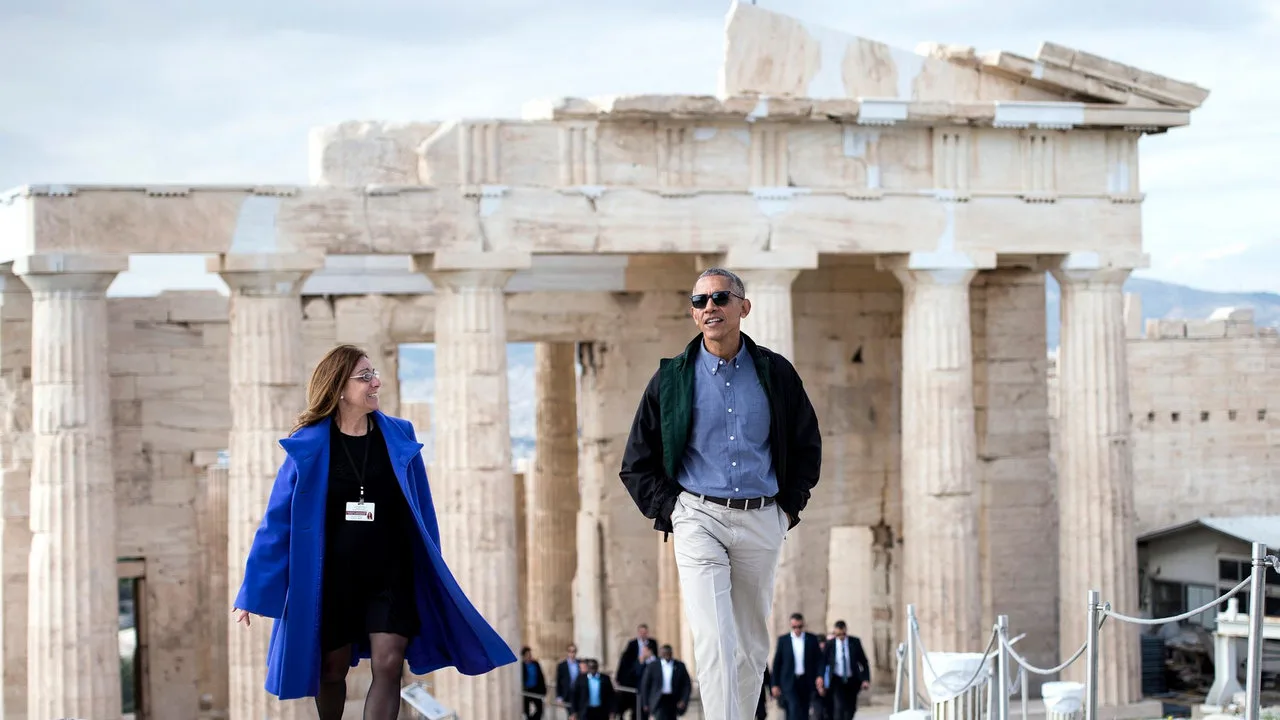
Climate change poses additional risks to the Acropolis, such as more frequent and intense heatwaves, which can cause thermal stress and cracking in the marble. Rising sea levels and changing weather patterns may also impact the site’s foundations and drainage systems. To mitigate these threats, the Greek government and international organizations have implemented various conservation measures, such as the use of protective coatings, structural reinforcements, and environmental monitoring systems.
Sustainable Tourism: Balancing Visitor Access with Conservation
Sustainable tourism is crucial for ensuring that the Acropolis can be enjoyed by future generations while minimizing the negative impacts of visitor traffic. Managing the flow of tourists is a key challenge, as overcrowding can lead to increased wear and tear on the site’s surfaces, as well as safety and comfort issues for visitors.To address these concerns, the Acropolis has implemented various visitor management strategies, such as timed entry tickets, designated walking paths, and visitor capacity limits. The site also promotes responsible tourism practices, encouraging visitors to respect the monuments, dispose of waste properly, and minimize their environmental footprint.
The Acropolis has also embraced technological solutions to enhance the visitor experience while reducing physical impacts on the site. The use of virtual and augmented reality tools, for example, allows visitors to explore the site in detail without physically interacting with the monuments. The Acropolis Museum also plays a crucial role in sustainable tourism by providing an alternative venue for learning about the site’s history and significance, reducing pressure on the Acropolis itself.
Resources:
- The Temple of Parthenon (link)
- UNESCO World Heritage Centre. (2021). Acropolis, Athens. link
- The Acropolis Museum (official website) link
- Editions of the Acropolis Museum link
- Hurwit, J. M. (2004). The Acropolis in the Age of Pericles. Cambridge University Press. link
- The Parthenon and its Impact in Modern Times (pp. 136-161). P. Tournikiotis link
- Neils, J. (2005). The Parthenon: From Antiquity to the Present. Cambridge University Press. link
- John H. Merryman, Thinking About the Elgin Marbles, 83 MICH. L. REV. 1881 (1985). link
- Greek Sculpture: The Classical Period by John Boardman (1995) link
- Hitchens, C. (1997). The Elgin Marbles: Should They Be Returned to Greece? Verso.link
- The Parthenon Frieze by Jenifer Neils (2001) link
- Acropolis Museum: Five successful years by the Professor Dimitrios Pandermalis link
- The Magical path to the Acropolis by Nick Papandreou. link
- Korres, M. (2000). The Stones of the Parthenon. J. Paul Getty Museum. link
- Kousser, R. (2005). Creating the Past: The Vénus de Milo and the Hellenistic Reception of Classical Greece. American Journal of Archaeology, 109(2), 227-250. link
- Papageorgiou-Venetas, A. (1994). Athens: The Ancient Heritage and the Historic Cityscape in a Modern Metropolis. The Archaeological Society at Athens. link

